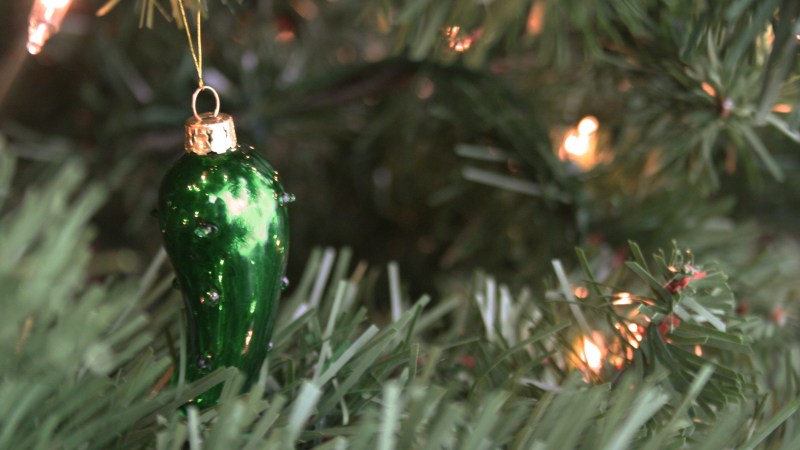Have you ever seen a glass pickle ornament hidden in the branches of a Christmas tree? Pickles and Christmas don’t really seem to go together, but for many Americans, the Christmas pickle is a beloved tradition.
In fact, the Christmas pickle is so popular that it was recently featured in Twitter Moments, and there is a shop that sells the traditional, mouth-blown glass pickle ornament with a card featuring its origin story. So, what is this tradition, and where did it come from?
What Is The Christmas Pickle Tradition?

The tradition is a simple one: sometime before Christmas Day, someone hides a glass pickle ornament in the branches of the family Christmas tree. On Christmas morning, the first child to find the ornament gets to open the first gift. Alternatively, the child may receive a special present.
The Christmas pickle helps keep kids from racing through the gift-opening process, and it teaches them to appreciate the time and thought that went into the Christmas preparations.
Where Did The Tradition Originate?
Most people believe that the pickle tradition originated in Germany, and many websites on the Internet will claim this as truth. But it isn’t clear whether or not the Christmas pickle is really German.
Back in 2016, YouGov, a market research firm, surveyed some German nationals, and only eight percent of respondents said they knew about the Christmas pickle. And, on top of that, only two percent said they practiced it.
In the 1880s, Woolworth stores did sell glass ornaments imported from Germany that looked like different fruits and vegetables. It is possible that pickles were a part of their selection. But it is a mystery as to whether or not the tradition started with them.
Old World Christmas sells the traditional ornament, and the company distributes its founder’s version of the pickle origin story with every pickle it sells. Company founder Tim Merck started importing ornaments from Lausch, Germany, in the early 1980s, but it is not known whether the pickle tradition was something he made up or something he heard about in Germany.

The pickle ornament has been the company’s bestseller for 37 years, and it sold over 25,000 last year.
The town of Berrien Springs, Michigan, held a Christmas Pickle Festival back in the 1990s, but according to a town historian, the town borrowed the pickle idea from Old World Christmas.
Silke-Maria Weineck, a professor of German studies and comparative literature at the University of Michigan and a German native, says that the Christmas pickle does not sound like a German tradition.
“German Christmas traditions are pretty solemn,” Weineck told TODAY Food by email.
It is possible that the tradition could exist in one specific region of Germany. It could even have come from one immigrant family to the United States, but there’s no way to know for sure.
“I could also imagine that we were originally dealing with an actual pickle prepared for the holidays. Americans are notoriously quick to claim something is ‘a tradition,'” explained Weineck.
Other Origin Stories
There are other theories about where the Christmas pickle tradition came from. One claims that a Civil War soldier from Germany was taken prisoner. When he was starving in jail, he begged for one last pickle before he died. When the guard took pity on him and gave him a pickle, the soldier summoned the mental and physical strength to survive.
There is also a scary medieval legend about two Spanish boys who were heading home for the holidays from boarding school. When they stopped for the night at an inn, the innkeeper murdered them and stuffed them into a pickle barrel. Then, later that night, they were miraculously brought back to life by Saint Nicholas.
Both of those stories seem pretty hard to believe. Chances are, a salesman back in the early 1980s invented a story to sell his inventory of glass pickle ornaments.
But no matter where the tradition came from, it is still a fun idea to incorporate into your festivities this holiday season.
